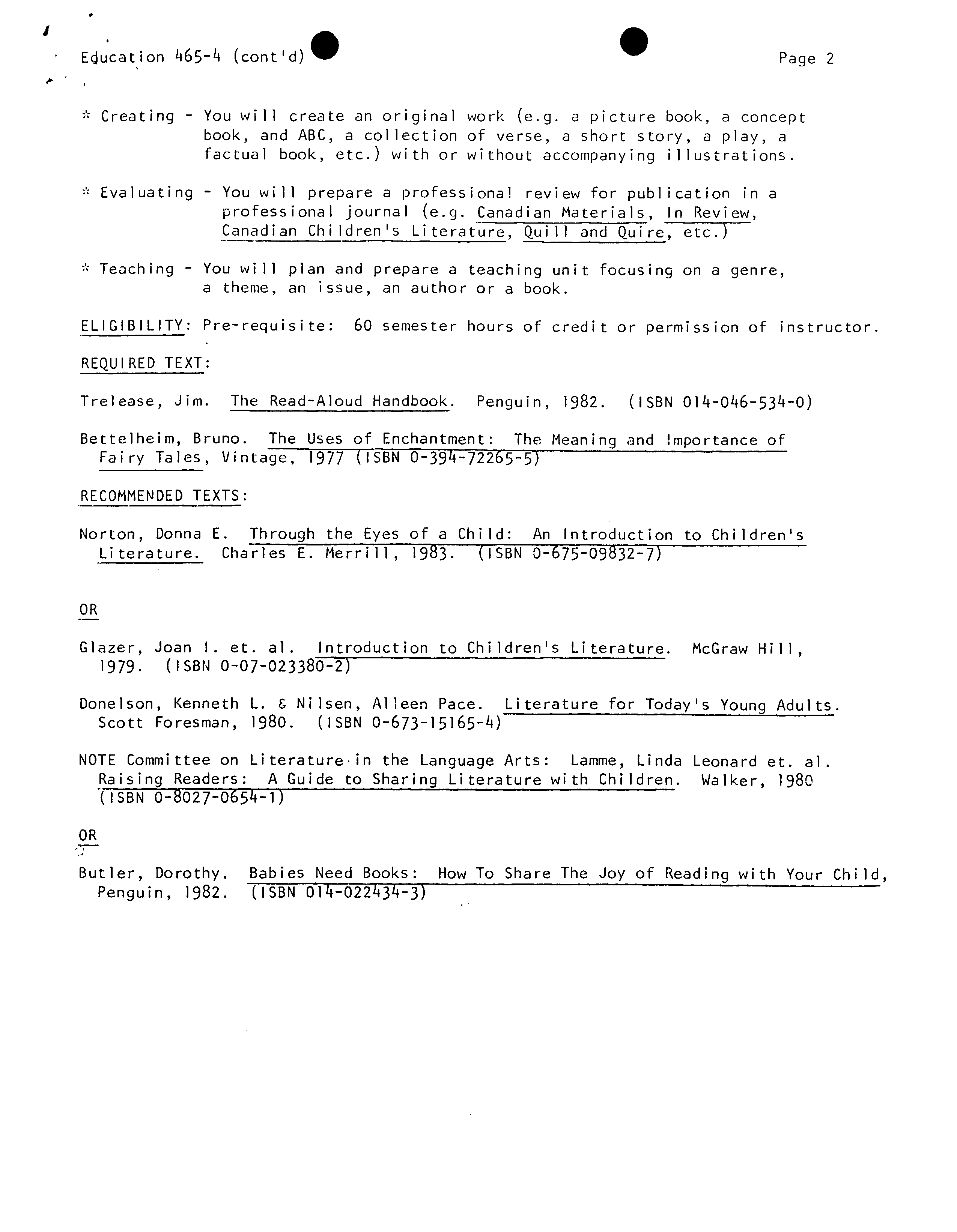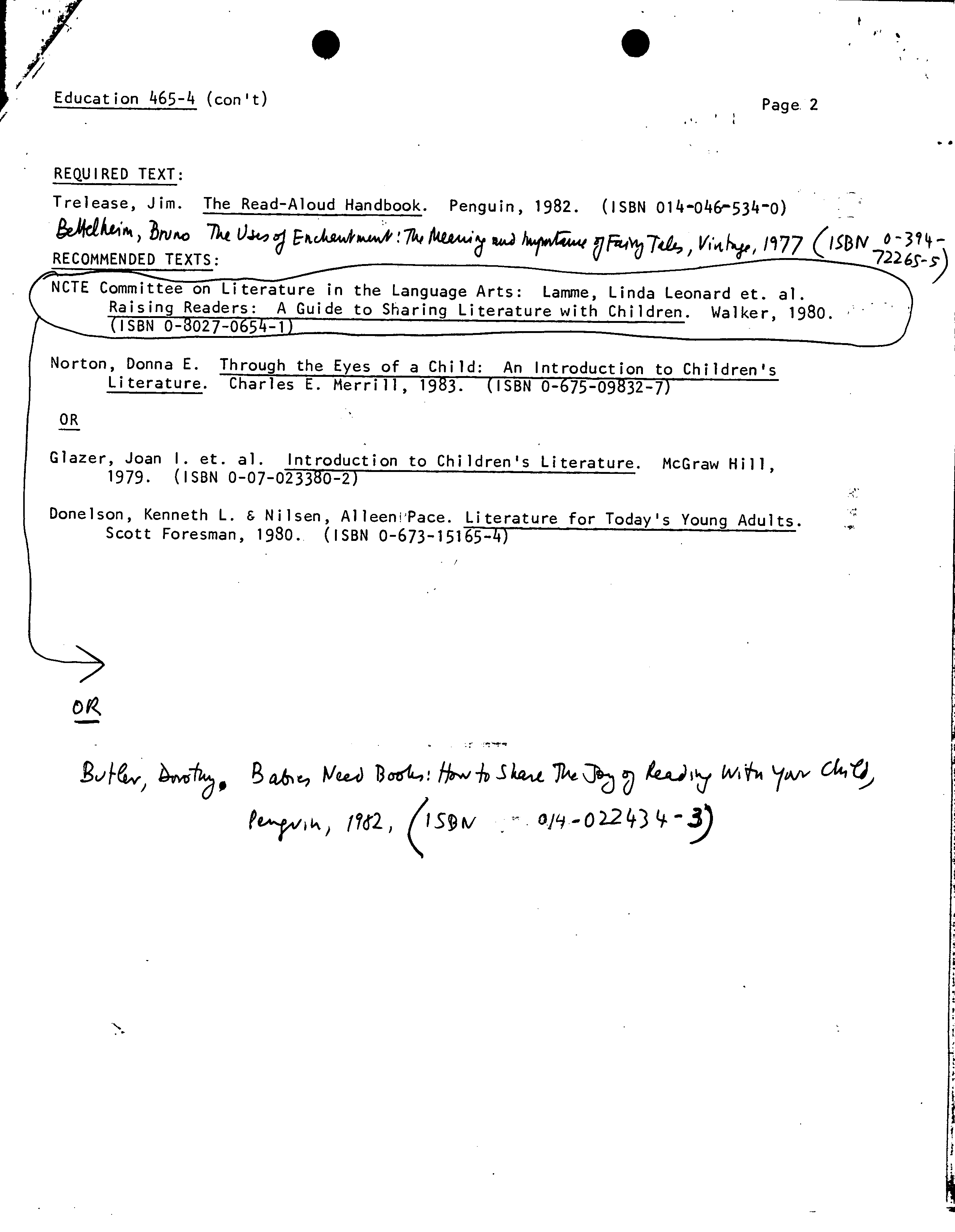*CATION 465-4 CHILDREN'S LITE!URE
FALL, 1984
?
INSTRUCTOR:. Prof.
Meguido Zola
CORRESPONDENCE
OBJECTIVES:
The course will introduce you to: a survey of the scope and selected aspects
of literature for children; the use of literature with children.
OUTLINE OF TOPICS:
The study of the scope and selected aspects of literature will exemplify a
variety of approaches ;
viz.:
- the historical and cross-cultural approach (e.g. the examination of
children's comics, magazines and annuals throughout the English-speaking
world during the last century)
- the genre approach (e.g. the examination of oral tradition, myth,
legend, fable, folk and fairy tales, etc.)
the theme and issue approaches (e.g. the exploration of such themes as
the family, friends
h
ip, school, etc., and of such issues as old age,
death, war, etc.)
The use of literature with children will focus on ways of planning for learning,
creating learning environments, and developing strategies, techniques and materials
in the use of children's literature in the school curriculum.
TYPICAL REQO I REMENTS:
The course will comprise of a broad range of experiences (lectures, seminars,
discussion groups, etc.) organized in such a way as to model a student-centered
approach and to maximize individualization of learning. The general requirements
are as follows:
Attendance and participation in all parts of the program.
Completion of readings, completion of journal cum resource book, completion of
assignments.
Demonstration of competency in the fulfillment of a selection of assignments.
The purpose of the assignments, of which only a selection is required, is to
initiate you into some of the roles, processes, and activities that a teacher
of literature engages in, namely:
Reading - You will read, study, and annotate a broad range of children's
literature according to criteria determined by your personal and
professional needs and interests.
Communicating - You will engage in a variety of experiences in communicating
literature with your peers or with children (e.g. storytelling,
reading aloud, reader's theatre, improvisation, etc.) with or
with ?
accompanying media and visual aids as appropriate.
1
?
Education
I65-4
(cont'd)
•
?
Page
2
Creating - You will create an original work (e.g. a picture book, a concept
book, and ABC, a collection of verse, a short story, a play, a
factual book, etc.) with or without accompanying illustrations.
Evaluating - You will prepare a professional review for publication in a
professional journal (e.g. Canadian Materials, In Review,
Canadian Children's Literature, Quill and Quire, etc.)
Teaching - You will plan and prepare a teaching unit focusing on a genre,
a theme, an issue, an author or a book.
ELIGIBILITY: Pre-requisite:
60
semester hours of credit or permission of instructor.
REQUIRED TEXT:
Trelease, Jim. The Read-Aloud Handbook. ?
Penguin,
1982. ?
(ISBN
O114-O46-5314-O)
Bettelheim, Bruno. The Uses of Enchantment: The Meaning and Importance of
Fairy Tales, Vintage,
1977
(ISBN
0-394-72265-5)
RECOMMENDED TEXTS:
Norton, Donna E. Through the Eyes of a Child: An Introduction to Children's
Literature. ?
Charles E. Merrill,
1983.
?
(ISBN
0-675-09832-7)
OR
Glazer, Joan I. et. a].
?
Introduction to Children's Literature.
?
McGraw Hill,
1979.
?
(ISBN
0-07-023380-2)
Donelson, Kenneth L. & Nilsen, Aileen Pace. Literature for Today's Young Adults.
Scott Foresman,
1980. ?
(ISBN
O-673-15l65-4)
NOTE Committee on Literature in the Language Arts: Lamme, Linda Leonard et. al.?
Raising Readers: A Guide to Sharing Literature with Children. Walker,
1980
(ISBN
0-027-065
OR
Butler, Dorothy. Babies Need Books: How To Share The Joy of Reading with Your Child,
Penguin,
1982.
?
(ISBN
O14-0221431-3)
0
Education
1
65_4
Children's Literature
INSTRUCTOR: Prof. Meguido Zola
LOCATION: on campus
OBJECTIVES:
The course will introduce you to: a survey of the scope and selected aspects of
literature for children; the use of literature with children.
OUTLINE OF TOPICS:
The study of the scope and selected aspects of literature will exemplify a variety of
approaches, viz.:
- the historical and cross-cultural approach (eq. the examination of children's
comics, magazines and annuals throughout the English-speaking world during
the last century)
- the genre approach (eg. the examination of oral tradition, myth, legend, fable,
folk and fairy tales, etc.)
- the theme and issue approaches (eg. the exploration of such themes as the
family, friendship, school, etc., and of such issues as old age, death, war,
etc.)
The use of literature with children will focus on ways of planning for learning, creating
learning environments, and developing strategies, techniques and materials in the use of
children's literature in the school curriculum.
TYPICAL REQUIREMENTS:
The course will comprise of abroad range of experiences (lectures, seminars, discussion
groups, etc.) organized in such a way as to model a student-centered approach and to
maximize individualization of learning. The general requirements are as follows:
Attendance and participation in all parts of the program.
Completion of readings, completion of journal cum resource book, completion of assignments.
Demonstration of competency in the fulfilment of a selection of assignments.
The purpose of the assignments,
of
which only a selection is required, is to initiate
you into some
of
the roles, processes, anJ activities that a teacher of literature
engages in, namely:
• Reading - You will read, study, and annotate a broad range
of
children's literature
according to criteria determined by your personal and professional needs and
interests.
uating - You will prepare a professional review for publication in a professional
journal (eg. Canadian Materials, In Review, Canadian Children's Literature
Quill and Quire, etc.).
• Creating - You wi
?
create an original work (eg. a picture book, a concept book, and
ABC, a collection of verse, a short story, a play, afactual book, etc.)
with or without accompanying illustrations.
• ?
Communicating - You will
___
engage
?
in a varie[ThTexperiences
-----
in communicating literature
with your peers or with children (eg. storytelling, reading aloud,
reader's theatre, improvisation, etc.) with or without accompanyingZ)
media and visual aids ?
pprp-F-i-a-t-e.
*
?
- ou will plan and prepare a teaching unit focusing on a genre, a theme,
an issue, an author or a book.
ELIGIBILITY: Pre-requisite: 60 semester hours of credit or permission of instructor.
/2
1
. ? .
/ ?
Education
1
+654
(con't) ?
Page.
2
REQUIRED TEXT:
Irelease,
&MA.ti,B
Jim.
rUft
?
The Read-Aloud Handbook. Penguin,
1982.
(ISBN
47
01046534r0)
?
I77 (/Sbtv
°
3' -
RECOMMENDED TEXTS:
NCTE Committee on Literature in the Language Arts: Lamme, Linda Leonard et. a].
R
aising Readers:
ISBN 0-8027-0664-1)
G
uide to Sharing Literature with
Children.
Walker,
1980.
Norton, Donna E. Through the Eyes of a Child: An Introduction to Children's
Literature. Charles E. Merrill,
1983. ?
(ISBN
0-675-09832-7)
OR
Glazer, Joan I. et. al.
?
Introduction to Children's Literature. McGraw Hill,
1979. ?
(ISBN
0-07-00-2)
Donelson, Kenneth L. & Nilsen, AlleeniPace. Literature for Today's Young Adults.
Scott Foresman,
1980.,
(ISBN
0-673-15165-4)
8M
?
Bw&; ?
L ?
V ?
bVv
d
Petri' f?d2,
?
.
GJ-o2-24)-3)




